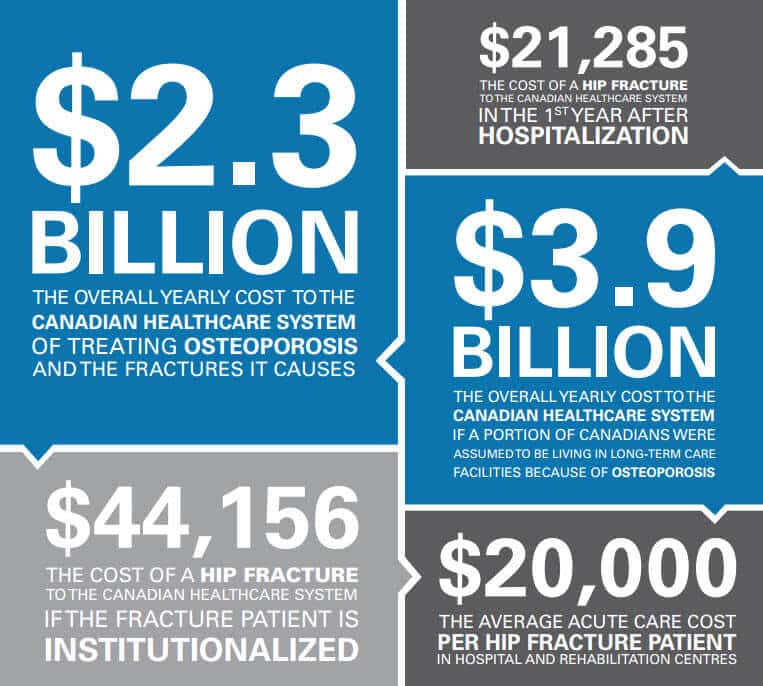In the first part of this series on osteoporosis, we defined the disease and discussed its high occurrence in both women and men (1 in 3 women and 1 in 5 men!).
Unfortunately, fewer than 20% of fracture patients are diagnosed and properly treated for osteoporosis. This may be related to why 28% of women and 37% of men who suffer a hip fracture will die within the following year.
With statistics such as these, it’s important to know if you are at risk for osteoporosis or if you have the disease.
Diagnosing Osteoporosis
If you or a family member has osteoporosis, early detection is essential for receiving the right treatment and taking the necessary precautions to live your life fully even with the disease.
Certain factors can increase your risk of developing osteoporosis, such as smoking, hereditary factors, alcohol, certain medical conditions, and simply age.
Osteoporosis Canada has a truly excellent checklist for determining your risk level for the disease. Click here to access it now!
Living with Osteoporosis
If you’re at risk for osteoporosis or you have been diagnosed with the disease, you can slow down its progression with some basic healthy living habits:
- Exercise for healthy bones: Ask your doctors about exercises that will help improve your muscle strength, prevent bone loss, and protect your spine. Balance exercises can also help prevent falls!
- Nutrition for healthy bones: Eat healthy, nourishing food and ensure you are getting a balanced diet with all the nutrients you need, like protein, calcium, and Vitamin D.
- Stop smoking and reduce drinking: Smoking and alcohol both reduce bone density.
There are also osteoporosis medications that can help those who are at a high risk of fracture. “Anti-resorptive” medications slow down the loss of bone mass, and “bone formation” medications increase the strength of bones. You must ask your physician if medication is right for your unique health profile and needs – and if so, which specific drugs are best for you.
In living with osteoporosis, the most important thing is to prevent falls, as you are much more likely to break a bone if you fall. Your physiotherapist or occupational therapist can help you reduce hazards in your home and provide tips for preventing falls as you go about your day-to-day activities.
Future Implications of Fractures
When elders are not properly diagnosed with osteoporosis and do not take the needed fall prevention precautions, unnecessary fractures are likely to occur. For the elderly, fracturing a hip or another bone can be devastating and debilitating; therefore, preventing falls must be a top priority.
When an elderly person has an osteoporotic fracture, it can turn into a healthcare crisis involving the emergency room, hospitalization, caregiving from family members and/or professionals, and sometimes long-term care requirements.
Overall Costs to the Canadian Healthcare System
As of 2010, additional yearly costs to health care system for treating osteoporosis and related fractures were $2.3 billion. If we add in the number of Canadians who now have to live in long-term care due to osteoporosis, overall yearly costs rise to $3.9 billion.
Overall Costs to the System per Hip Fracture Patient
For each person who suffers from a hip fracture – and there are 30,000 annually in Canada – the average cost to the system in the first year after hospitalization is $21,285.
However, if the patient is institutionalized, the average cost to the system during the first year more than doubles, becoming $44,156.
Where Do Patients Go after Hip Fracture?
After being discharged from the hospital after a hip fracture, here is where patients go:
- 44% return home
- 10% go to another hospital
- 27% go to rehabilitation care
- 17% go to long-term care
How Many Patients Re-fracture?
Osteoporosis Canada also provides us with some disturbing predictions about how many hip fracture patients will re-fracture –33% within one year and an unsettling 50% within five years!
As you can see, proper diagnosis, treatment, and prevention is critically important for our families, our healthcare system, and the often-unpaid caregivers who care for mom or dad after their fracture.
I’d like to end on this note: if you are dealing with osteoporosis – stay positive! You are not alone, and many people live happy, full lives with this disease.
Please visit the Osteoporosis Canada website for more details about osteoporosis and, specifically, tips for preventing falls.
Your parents. Our priority. Silver Sherpa becomes your trusted co-pilot with specialized planning, coordination, and assistance services to help the elderly and their families get the care and support they need. Schedule a complimentary consultation with us today.
*Silver Sherpa are not medical professionals. The advice in this blog is not intended as a substitute for medical advice.
You may also be interested in:

